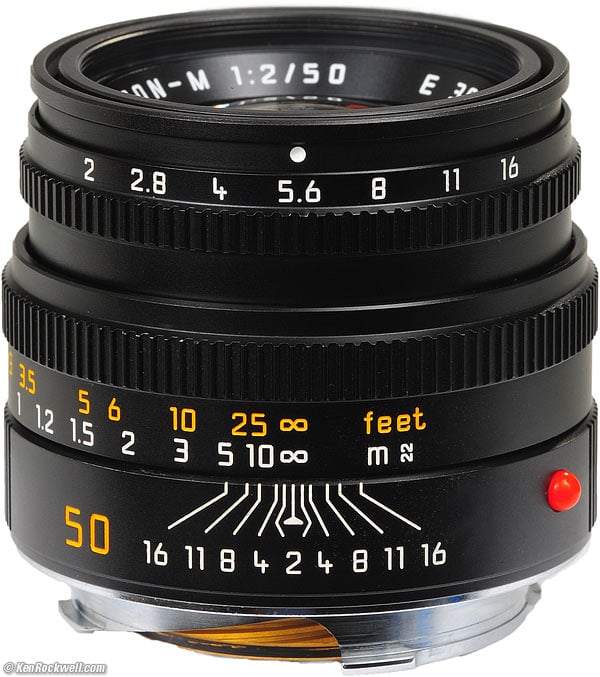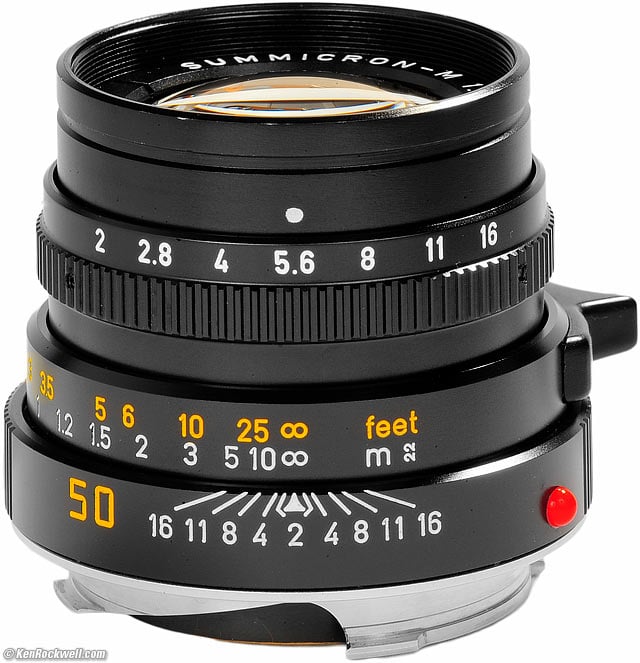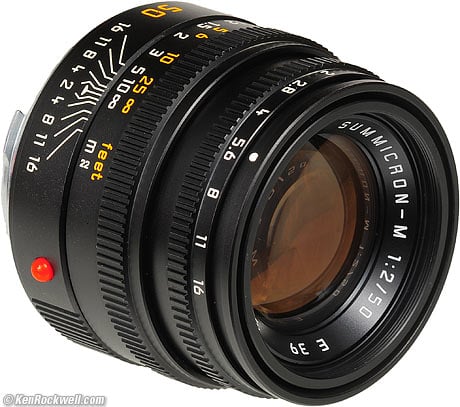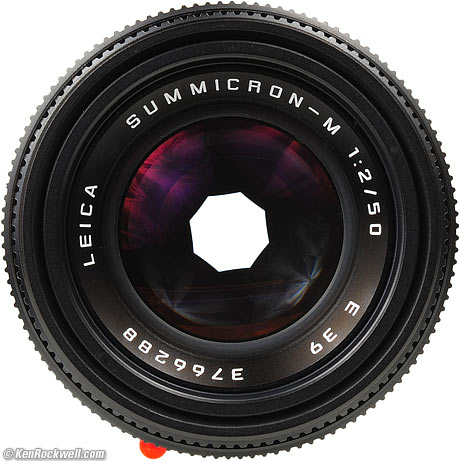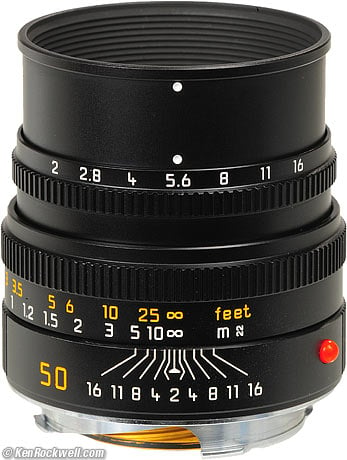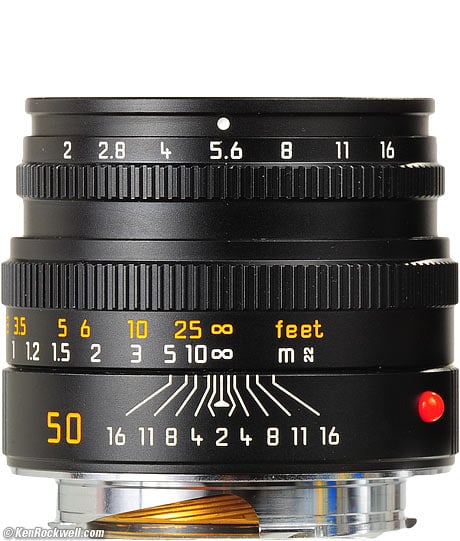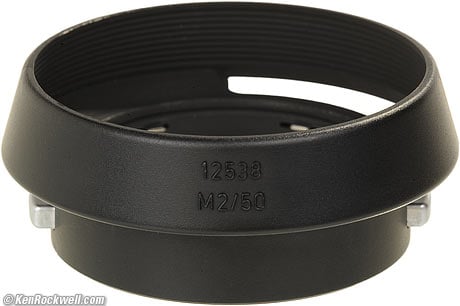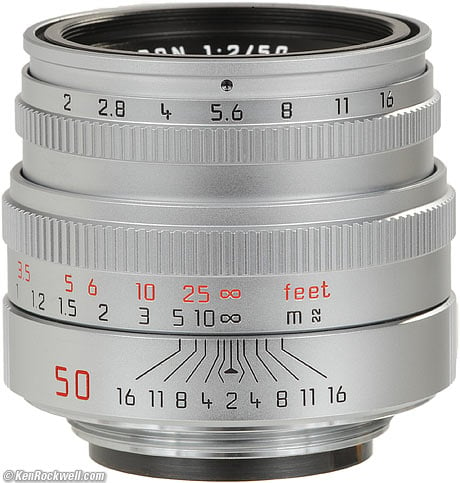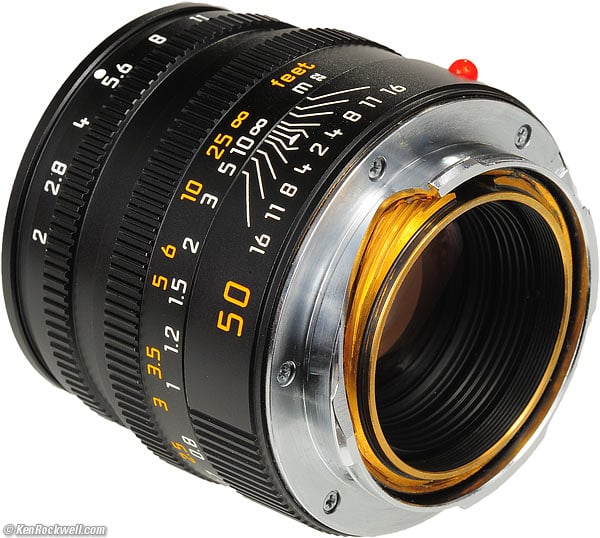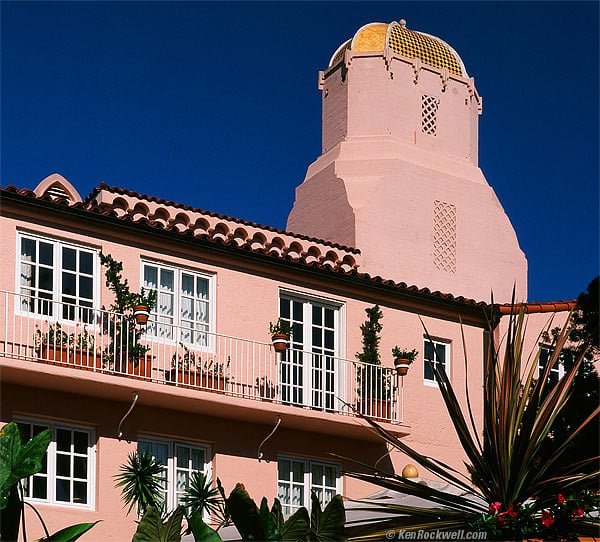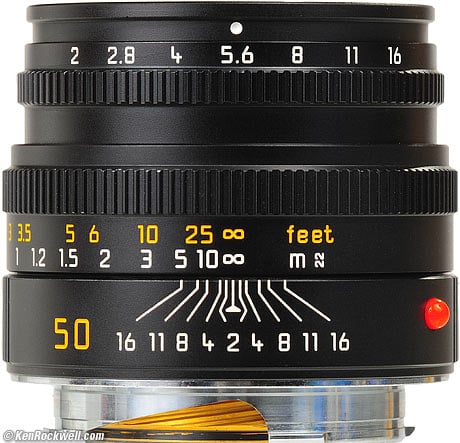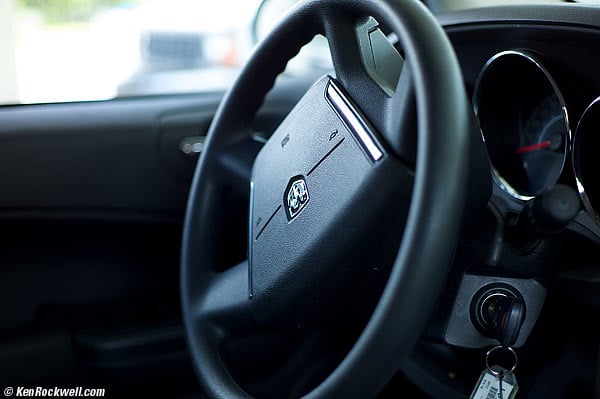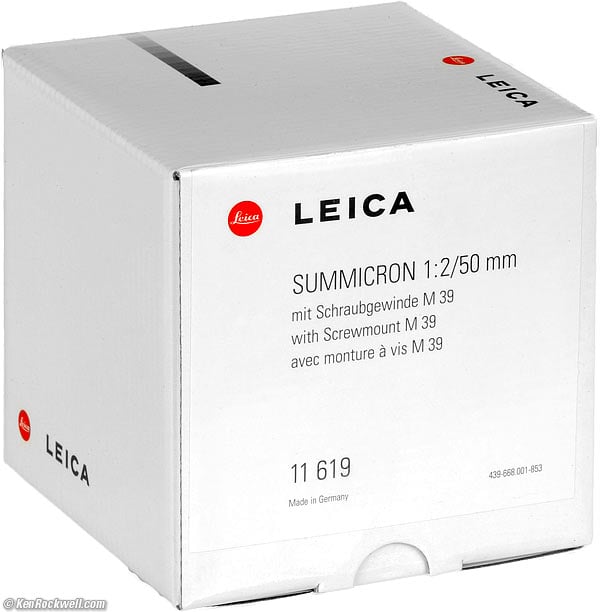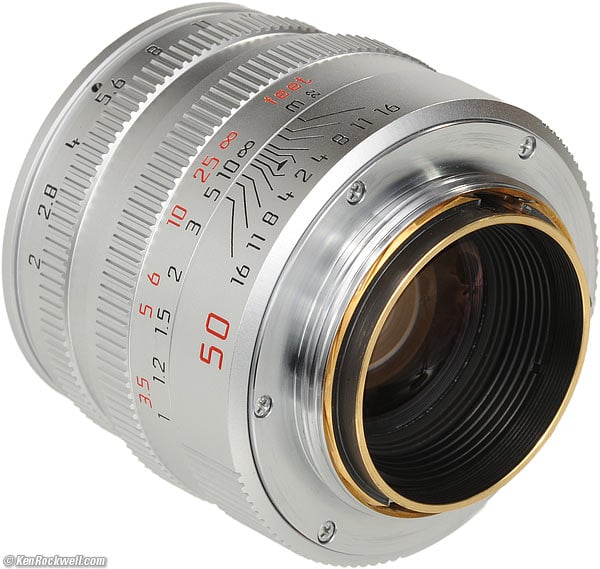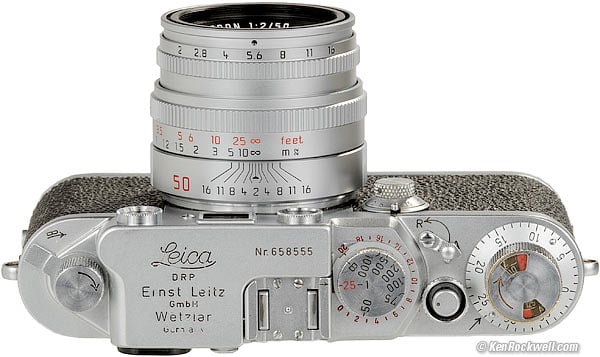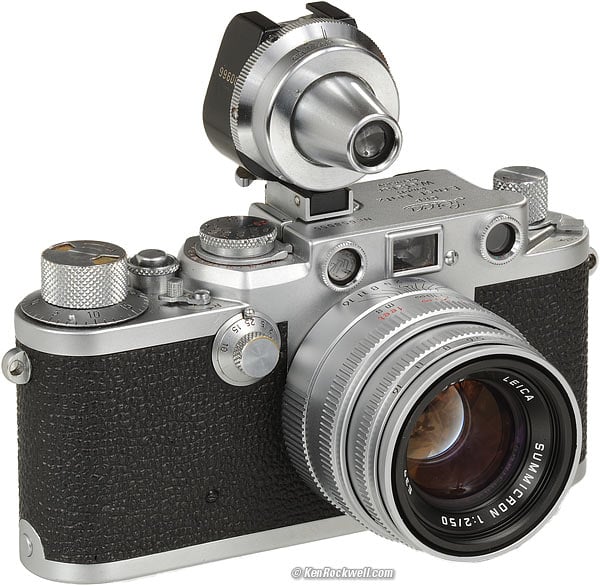Home Donate New Search Gallery Reviews How-To Books Links Workshops About Contact
LEICA 50mm f/2
SUMMICRON-M (1979-today)
Intro Specs Performance Screw-Mount Version Compared Recommendations
LEICA SUMMICRON-M 50mm f/2 (1994-2013 version, 39mm filters, foreskin-style hood, 8.5 oz./242g, about $2,000 new or $1,100 used). enlarge. You can get them new or used from Adorama and of course used at eBay (see How to Win at eBay). This free site is supported by your using those, and these links, when you get anything, regardless of the country in which you live. Thanks! Ken.
LEICA SUMMICRON-M 50mm f/2 (1979-1994 version, 39mm filters, separate clip-on A42 hood, 6.7 oz./195g). enlarge.
Both these versions share identical optics. I prefer the earlier version with the clip-on hood. Its hood works better, it doesn't keep collapsing as does the push-in/pull-out hood of the newer version, and it weighs less than the newer versions.
January 2014 LEICA Camera Reviews LEICA Lens Reviews All Reviews
LEICA SUMMICRON 50mm f/2 Guide, 1953-present.
Sample Images
Yosemite in Springtime May 2011
Yosemite in Winter February 2010
California's Gold Country April 2010
Introduction top
Intro Specs Performance Screw-Mount Version Compared Recommendations
|
I personally buy from Adorama, Amazon, Ritz, B&H, Calumet and J&R. I can't vouch for ads below.
|
There is no better 50mm lens on Earth than the LEICA SUMMICRON-M 50mm f/2. The SUMMICRON is the world's reference for a 50mm photographic lens.
The LEICA SUMMICRON-M 50mm f/2 is 100% compatible with every LEICA M camera from the LEICA M3 of 1954 through today's LEICA M7, MP and the LEICA M9.
The LEICA SUMMICRON has always been the world's standard for performance, and my tests of this newest version prove that this reputation is earned, not given. This is an extraordinary lens.
Before I get too involved, let me caution that any 50mm lens can make great pictures. The only way to see the difference between this $2,000 SUMMICRON-M and, say, an $8 50mm f/1.7 SMC Pentax-M shot on a K1000, is if you're counting every pixel and shooting at large apertures like f/2.8. At normal apertures like f/8, the differences go away. As I go off extolling the manifold virtues of the SUMMICRON-M, remember that these differences are very difficult to see in almost anything other than exacting tests.
A few people would think it's crazy to spend $2,000 on a 50mm lens, and I do, too. But let's think about this for a moment. As I write this, most of you are shooting the Nikon 24-70mm f/2.8 AF-S or the Canon 24-105mm f/4 L IS when you need the 50mm focal length to fill in between your 70-200 and your wide zoom. The plastic Canon costs over $1,000, the Nikon costs $1,750, and you people buy these at the drop of a hat. Both these SLR lenses are new enough that even if you could find them used, you're still into them for over a grand.
The LEICA lens you see pictured here was bought used in 2009 for about $900 at this link to them at eBay, still in its original box, and has performance far beyond either of the two lenses most hobbyists use. This LEICA lens has optical performance worlds beyond either of those zooms, weighs a fraction as much, and is one or two stops faster. Let's be honest: midrange zooms are really only used to fill-in between your tele and wide zooms, and a fixed 50mm is all you really need.
The fast f/2 speed of this SUMMICRON lets you shoot the same thing at the same shutter speed with an ISO of one-half or one-quarter that you could with the Nikon or Canon zooms. Considering that you can get this LEICA lens for less money than one of those zooms, who's crazy now?
Today's LEICA SUMMILUX-M 50mm f/1.4 ASPH is a stop faster, but bigger, heavier, ergonomically less pleasant and less sharp. Nothing beats a SUMMICRON.
This LEICA SUMMICRON-M 50mm f/2 is the oldest optical design in Leica's catalog, having been introduced in 1979. I'm usually showing the current cosmetic version, made from 1994-today. The earlier 1979-1994 version has the same superior optics and a focus tab instead of a ring, but has no built-in hood. Either lens is the best there is.
Because every other LEICA SUMMICRON f/2 lens has been updated to ASPH (28mm in 2000, 35mm in 1996, 75mm in 2005 and 90mm in 1998), a LEICA SUMMICRON-M 50mm f/2 ASPH seems like a logical update, however LEICA tells me this is unlikely simply because the performance can't be much improved, but the price would become about the same as the f/1.4, so why bother? Hey, why bother to send men to the Moon? We bother precisely because we are men and continuously must explore and improve.
There is no better 50mm lens, or any lens for that matter.
Every image of this little lens has been enlarged to fit the page. Compared to SLR lenses, or Leica's own 50mm SUMMILUX lenses, this is a very small lens taking tiny 39mm filters.
LEICA SUMMICRON-M 50mm f/2. enlarge.
Specifications top
Intro Specs Performance Screw-Mount Version Compared Recommendations
Name
Leica calls this the LEICA SUMMICRON-M 50mm f/2.
Optics top
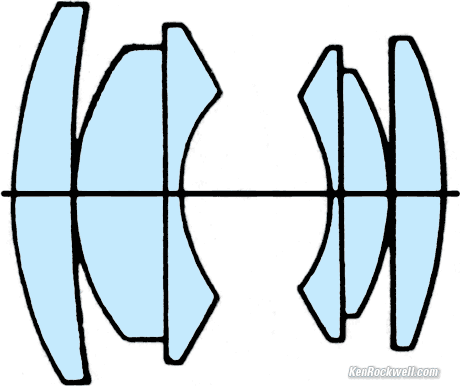
Cross-section, classical rendition.
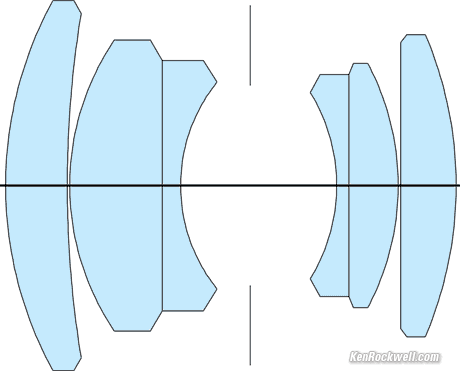
Neue rendition. It's the same design, with different mounting edges.
6 elements in 4 groups, double-Gauss variant.
Five surfaces are planes.
Mostly single-coated in magenta.
Diaphragm
LEICA SUMMICRON-M 50mm f/2. enlarge.
8 blades.
Stops down to f/16.
Half-stop clicks.
Close Focus
Marked: 0.7m and 2.5 ft.
Measured: 0.66m (26" or 2.17 ft).
(M39 screw mount version: 1 meter.)
Maximum Reproduction Ratio
1:11.5, M version.
Size top
Extension from flange: 43.5 mm (1.713"), focused at infinity, specified. Earlier version (1979-1994) was about 43mm long.
Maximum diameter: 53mm (2.09"), specified, current version
39 x 0.5mm screw-in filters.
Earlier version accepted A42 42mm press-on and clip-on front caps and hoods.
Weight top
Current version (1994-today)
Lens alone: 8.543 oz (242.15g), measured, black version.
8.5 oz. (240g), specified, black anodized aluminum version.
11.8 oz. (335g), specified, chromed brass version.
M39 Screwmount version (1999)
11.450 oz. (324.65g), measured.
Previous version (1979-1994)
6.970 oz. (197.6g), measured, in black.
6.9 oz. (195g), specified, in black.
12 538 plastic hood: 0.445 oz. (12.6g), measured.
Fonts top
The earliest versions used the old round fount, today's versions use Leica's LG1050 squared font, and ones in-between use combinations of the two:
"50" |
Depth-of-field |
Focus |
Aperture |
Front Ring |
|
1979-1989 |
square |
round |
round |
round |
round |
1989-1991 |
square |
square |
square |
round |
round |
1991-today |
square |
square |
square |
square |
square |
Hood top
LEICA SUMMICRON-M 50mm f/2 (1994-today) with hood extended. enlarge.
The latest (1994-today) version has a telescoping hood. Just slide it out. It does not rotate and it does not lock.
True to „Deutsche Gruendlichkeit“ (German thoroughness), there are two aperture index dots on the hood. One is for each position of the hood.
Roll mouse over to see hood extend!!!
The older 1979-1994 version came with a plastic 12 538 hood. The tabs and clip locks are metal, while the rest is plastic:
LEICA 12 538 plastic hood (fits only SUMMICRON from 1953-1994). expand.
The older 1979-1994 version has LEICA's standard A42 front mount, so it takes any of the usual collection of A42 clip-ons, like the earlier metal 12 585.
Caps top
Front cap (current SUMMICRON with built-in-hood, 1994-today)
LEICA 14 038, E39 clip-on plastic.
It is poorly designed: this cap often pops off. Leica's 1950s and 1960s push-over caps were much nicer, but won't work with the integral hood version of this lens.
If you use a filter, this cap will always be popping off.
If you have a lens with the built-in hood and use filters, a smarter idea is to reserve the LEICA 14 038 E39 front cap, and instead use the MADE-IN-GERMANY Kaiser 40mm Objectiveschutz-deckel instead. It's a tight fit over a 39mm filter, so it's going to stay on and do its duty, unlike LEICA's weak 14 038 snap-cap.
Front cap (previous SUMMICRON with separate hood, 1979-1994)
Push-on plastic A42 cap, standard.
Any of the classic solid-brass, Hungarian yak-felt lined push-on caps work, too.
Cap for reversed 12 585 hood (previous lens with separate hood, 1979-1994)
LEICA 14 033, snap-over plastic.
Cap for 12 585 hood in shooting position
I use a modern SLR 55mm snap-in cap, which fits over and inside the front of the 12 585 hood.
Rear cap
Standard 14 269 plastic rear cap.
Part Numbers (Verk. Nr.) top
Front cap: 14 038, clip-on plastic.
Rear cap: standard M 14 269, plastic.
Current model lens (1994-today)
11 826 in black anodized aluminum (242g).
11 816 in chromed brass (335g).
11 624 in "titan coated brass."
11 615 (special edition 2002): in the same style as the rigid 1956 SUMMICRON, but with the modern squared font, to commemorate the 50th anniversary of the 1952 SUMMICRON. Leica also goofed in making this commemorative in M-mount, which did not exist in 1952, but would have allowed universal compatibility with all LEICAs, as the M39 version does.
M 39 screw mount version (1999). enlarge.
11 619 (special edition 1999): Leica made a small run of these in traditional M39 screw mount for Leica's original 1932-1960 cameras like the LEICA IIIf. They are otherwise the same as the current model, with 39mm filters, a built-in hood and ring focus. Hewn from solid brass, these screw-mount chrome beauties weigh 324.65g (11.450 oz.).
Comes with standard 39mm 14 038 clip-on plastic front cap, fitted leather case specific to it, and aluminum rear screw cap.
Previous version lens (1979-1994)
11 819 in black anodized aluminum (195g, schwarz).
11 825 in chromed brass (silber chrom).
Scope of Delivery top
Lens.
Caps.
Leather case.
Impressive paperwork.
LEICA SUMMICRON-M 50mm f/2. enlarge.
Performance top
Intro Specs Performance Screw-Mount Version Compared Recommendations
Overall Bokeh Diaphragm Calibration Distortion Ergonomics
Falloff Finder Blockage Focus Lateral Color Mechanics
Overall top
The LEICA 50mm SUMMICRON-M is the world's reference for high performance. There is no better-performing 50mm lens, period. The SUMMICRON-M is superior even to the LEICA SUMMILUX-M 50mm f/1.4 ASPH.
The real question one needs to ask oneself is if you care; used properly, any other 50mm lens also can give extraordinary results.
The superior optics of the LEICA SUMMICRON-M 50mm f/2 are most apparent when looking at huge prints made at large apertures, where lesser lenses have reduced performance.
LEICA shooters don't waste time counting pixels. They just shoot.
La Jolla's La Valencia, 16 November 2010. bigger.
1952 LEICA IIIf, Velvia 50, 1999 LEICA SUMMICRON 50mm f/2 (M39), 2008 B+W MRC 39mm 81A, 1/100 at f/11, Pocket Light Meter application on my iPod Touch, NCPS process and scan.
Bokeh performance top
Bokeh, the quality of out-of-focus areas as opposed to the degree of defocus, is poor.
Backgrounds don't completely evaporate at f/2; sadly the blur circles have enhanced edges.
f/2.8 isn't much better.
f/4 and smaller can be good, because we've now clipped off the brighter edges of the blur circles, but in practice, bokeh is still poor at f/4.
By the time you've stopped down to f/5.6, who cares: your background is now all in focus.
Here are crops from extremely enlarged prints of about 26 x 40" (65 x 100cm), or the equivalent of looking at LEICA M9 images, shot at the 10MP setting, at 100% on-screen.
In these examples, a vertically polarized phase lattice was set up at 3 meters (10 feet) on which the SUMMICRON-M was focused, and the synthetic reference vegetation seen out of focus in the background was at 15 meters (50 feet).
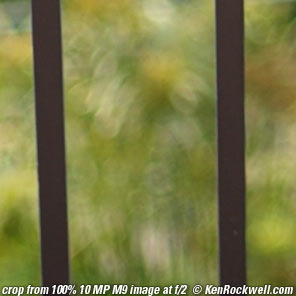 |
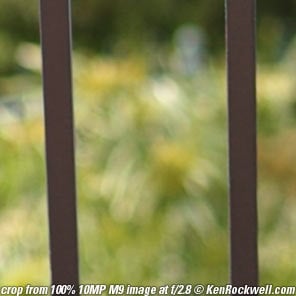 |
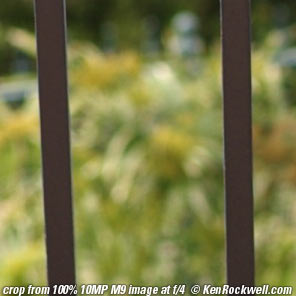 |
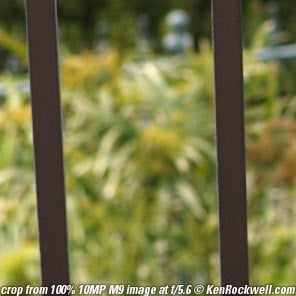 |
Here are crops from extremely enlarged prints of about 35 x 52" (90 x 135cm), or the equivalent of looking at the center of 18 MP LEICA M9 images, shot as DNG and converted in Apple Aperture 3, at 100% on-screen.
In these examples, a vertically polarized phase lattice was set up at 3 meters (10 feet) on which the SUMMICRON-M was focused, while synthetic reference vegetation seen out of focus in the background was at 15 meters (50 feet).
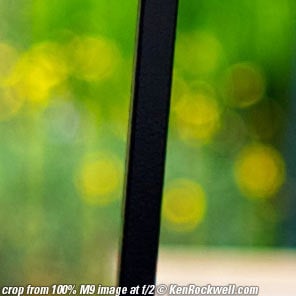 |
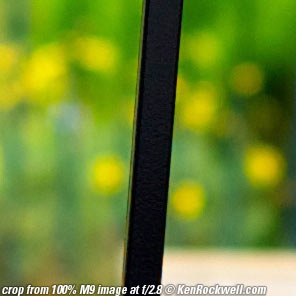 |
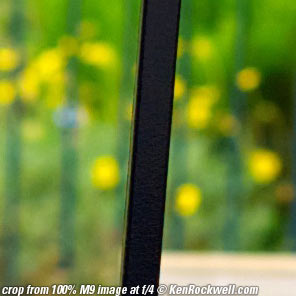 |
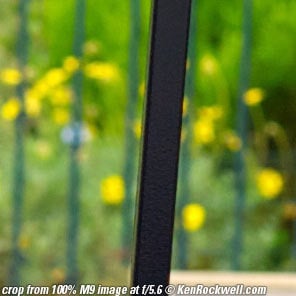 |
Bokeh is worse than the SUMMILUX 50mm f/1.4, but nowhere near as good as the LEICA SUMMILUX 50mm f/1.4 ASPH. (click each for its own bokeh examples shot at the same time.)
Diaphragm Calibration top
The calibration is right-on: the meter in my M9 tracks each half-stop click perfectly.
Distortion top
The LEICA SUMMICRON-M 50mm f/2 has no visible distortion. Shoot it on the M9 at any reasonable distance, blow it up to 200% on-screen, drop a ruler on it in Photoshop, and it's still perfectly straight.
The SUMMICRON has always been a huge improvement over today's newest SLR lenses, like the Nikon 50mm f/1.4 AF-S, which often have noticeable barrel distortion.
If you shoot at closer distances, you might want to correct the invisible distortion using these figures in Photoshop's lens distortion filter for critical photogrammetric work:
Correct with |
|
∞ |
-0.1 |
3 meters (10 feet) |
0.0 |
1 meter (3.3 feet) |
+0.4 |
0.66 meters (2.2 feet) |
+0.4 |
© 2010 KenRockwell.com. All rights reserved.
Ergonomics top
LEICA SUMMICRON-M 50mm f/2. enlarge.
The little SUMMICRON-M is wonderful.
Focus is immediate, and so is aperture setting, just like almost every other LEICA lens.
It gets no better than this.
Falloff (darker corners) top
This SUMMICRON-M has a small amount of falloff at f/2, and none by f/4.
For actual photography, it's minor at f/2, and invisible by f/2.8.
I've greatly emphasized it below by shooting a gray field and presenting it against another gray field
LEICA SUMMICRON-M 50mm f/2 falloff on full-frame M9 at infinity, 11819/11825/11826/11816 profile used:
© 2010 KenRockwell.com. All rights reserved.
|
Finder Blockage top
The earlier (1979-1994) version has a smaller front (A42) and shouldn't have any blockage when used without the hood.
The current (1994-today) version has a wider front, which is the telescoping hood. It can cause a little bit of blockage.
With the hood retracted, this current LEICA SUMMICRON-M 50mm doesn't block finders when focused at 3 meters (10 feet) or father. At closer distances, there is a little blockage.
With the hood extended, there no blockage at infinity, which gets a little worse as focused more closely.
In any case, it's so little that I couldn't remember any until I actually went back and tried it to document for this review. At worst, at 0.66m with the hood extended, 1/4 of the lower right is blocked, not a big deal.
Focus top
Focus accuracy is a personal issue between your sample of body and your sample of lens. This said, the sample I tested gave dead-nuts-on focus with every body I tried, which is better than any other 50mm lens I've used.
The focus helicoid is geared pretty fast. It takes very little motion to make big changes in focus, so focus is very fast. It's not very precise, but as I've shown, it is always perfect, so this is the best of all worlds.
If you're used to other lenses, like the classic 50mm SUMMILUX with its super-precise focus gearing, you may be in for a bit of a shock as the rangefinder images move very quickly as you turn the focus ring.
Lateral Color Fringes top
There no color fringes anywhere. This is the world's performance reference.
Materials and Construction top
This black SUMMICRON-M is weaker than classic brass lenses like the 50mm Rigid SUMMICRON and SUMMICRON with near-focusing range of the 1950s and 1960s, but too bad; it weighs less, too.
Filter threads, barrels, aperture and focus rings: Black anodized aluminum, or chromed solid brass.
Focus helicoids: Brass.
Markings: Engraved and filled with paint.
Bayonet mount: Chromed brass.
Red index dot: Red plastic. (none on M39 version.)
Sharpness top
The more you know about photography, the more you know that lens sharpness doesn't matter.
That said, this is among, if not the, world's sharpest lens. If you're not getting sharp pictures, you're doing something wrong.
In the center, it's sharp and contrasty even at f/2. In fact, it's so sharp at f/2 that it can excite aliases (moiré) in the M9 throughout the entire field, even wide-open.
Like most double-Gauss derived normal lenses, it is least sharp in a doughnut of about 15mm image radius. In this band, the classic 50mm SUMMILUX is relatively horrible, while even at f/2 this newest SUMMICRON is far superior to the SUMMILUX. In this critical band, this SUMMICRON is as sharp at f/2 as the SUMMILUX is at f/5.6-8! This isn't from reading MTF curves; this is from my actual hands-on comparison tests.
This LEICA 50mm SUMMICRON-M is so good at f/2 that it's very difficult to see any improvement as stopped down. Resorting to numerical analysis and integrating the entire field, it's sharpest at f/8, as are most lenses.
This is Leica's sharpest 50mm lens in at least 85 years. The current LEICA SUMMILUX 50mm f/1.4 ASPH is much less sharp at larger apertures. I've shot direct comparisons with about eight other samples of every other LEICA 50mm going back to the first LEITZ ELMAR 50mm f/3.5 of 1925, and this SUMMICRON-M easily wins every time.
Spherochromatism top
Spherochromatism, or color fringes on out-of-focus highlights, is minor.
Out of focus background highlights may show green fringes and out-of-focus foreground highlights may show magenta fringes, but it's rarely visible unless you go looking for it.
Full image from LEICA M9 at f/2, focused on ram's head.
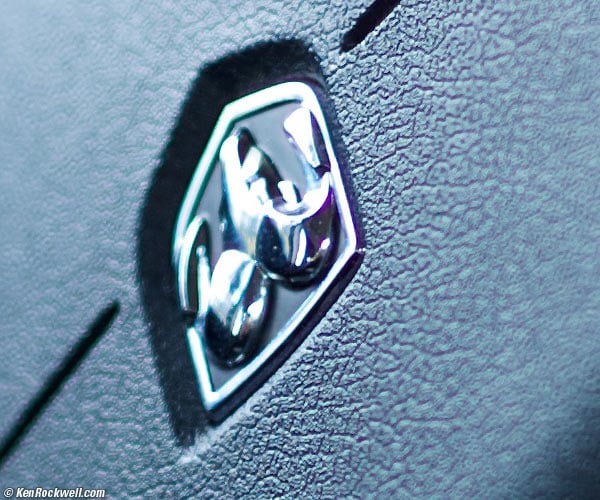
Crop from above LEICA M9 image at 100%.
M39 (screw-mount) version top
Intro Specs Performance Screw-Mount Version Compared Recommendations
M39 Intro M39 Specs M39 Performance M39 Usage M39 Recommendations
SUMMICRON 50mm mit Schraubgewinde M39 LTM Screwmount (1999). enlarge.
In 1999, responding to requests from customers who hadn't seen any new screwmount lenses from Leica since 1960, Leica minted some of these 50mm SUMMICRONs (and some 35mm SUMMICRON-M ASPH) in its traditional M 39 screw mount, also called Leica Thread Mount (LTM). It's a 39mm thread in either 26 TPI or 1.0mm pitch, depending on how you stretch your calipers. Leica sold these only in Japan.
This chrome lens is made of solid brass, and therefore 34% heavier than the standard black aluminum version.
This version is completely compatible with all of Leica's traditional cameras made from 1932 through 1960, especially the ever-popular LEICA IIIf, which has sold far more than any of Leica's attempts at digital kameras. With a simple adapter ring, it's also perfectly compatible with all LEICA M cameras.
M 39 Screw Mount Specifications
Box, LEICA SUMMICRON 50mm f/2 M 39 LTM Screwmount (1999). enlarge.
Name
Since it's not an M lens, it's called simply a LEICA SUMMICRON 50mm f/2, not a SUMMICRON-M.
Optics and Diaphragm
Identical to M version.
Close Focus
As thread-mount cameras' rangefinders focus only to 1 meter, this version's helicoids focus only to 1 meter, not 0.7 meters as do the M versions.
Weight
Made of solid brass, it weighs 11.450 oz. (324.65g).
Rear, LEICA SUMMICRON 50mm f/2 M 39 LTM Screwmount (1999). enlarge.
The optics of the M39 version are identical to the M versions.
1999 SUMMICRON-M 50mm M39 on 1952 LEICA IIIf. enlarge.
The 1999 SUMMICRON is larger than the traditionally tiny screw-mount lenses, therefore it blocks some of the LEICA's internal viewfinder, which is very close to the lens to avoid parallax problems. The largest part of the obstruction isn't its hood or filter; it's this lens' fat base and focus ring:
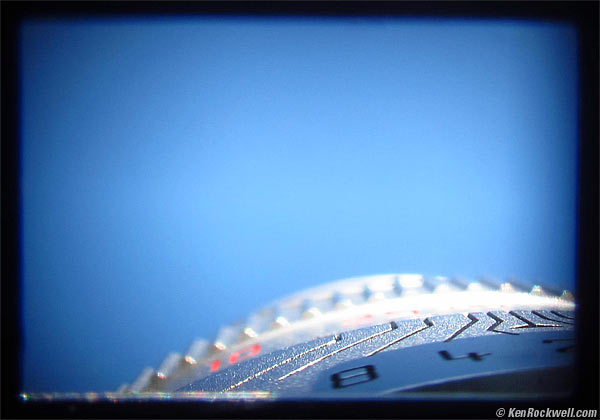
Blockage as seen through LEICA IIIf's internal finder.
Since the point of a viewfinder is to see what we're doing, the slip-in VIOOH finder is suggested, as it is more precise and more accurate than the camera's finder, with sharp edges to its frame, and it clears the lens for an unobstructed view.
1999 SUMMICRON 50mm M39 on a 1952 LEICA IIIf with VIOOH FInder. enlarge.
This version also works perfectly with all LEICA M kameras, including the newest LEICA M9 digital, with the use of a simple adapter ring. Focus, metering, and everything is exactly as if it were an M lens. Thus, if you luck into one of these beauties, it works perfectly with every LEICA ever made, far better than if you bought only an M version.
Everyone with a screw mount camera wants one of these, but there are a few r
reasons it might not be worth your bother if you only intend to use it on a screw-mount camera:
1.) Finder blockage, as shown above, compared to the smaller original screw mount lenses.
2.) The pull-out hood of this lens is awful compared to the clip-on A42 hoods of earlier 50mm lenses. This pull-out hood slides back-in on its own, and blocks the finder more than hoods like the 12 585.
3.) It's so heavy that it will make the little screw-mount LEICAs front-heavy. You may start to ask yourself why exactly you bothered to get this.
4.) Even though the precision of the screw-mount cameras' rangefinders is better than today's LEICA M, they are usually not as accurate over all distances. Your LEICA technician can perfect the focus at one distance, but not all. It is likely that you won't get perfect focus at every distance, in which case, any performance improvement over classic lenses, like the original 1953-1960 screw-mount 50mm LEICA SUMMICRON, become meaningless.
Strange but true, the depth-of-field of this new lens is shallower than earlier lenses, because its higher performance stands-out more in its plane of perfect focus from the rest of the image. Therefore, unless you know you'll get perfect focus, technical quality on a screw-mount camera could be higher with classic lenses.
For the best results, shoot enough to know your camera's personality so you can trim focus manually at distances that need it.
Compared top
Intro Specs Performance Screw-Mount Version Compared Recommendations
Compared to every other 50mm SUMMICRON made since 1953
Compared amongst the slower 50mm lenses
Voigtländer 50/1.1, LEICA 50/1.4, Zeiss 50/1.5, Zeiss 50/2, LEICA 50/2. bigger.
| Dates | 2010- |
1961-2004 |
2004- |
2004- |
1979- |
| Filter | 58mm |
43 or 46mm |
46mm |
43mm |
39mm |
| Length | 57mm |
46mm |
38mm |
43mm |
43mm |
| Finder Blockage | severe |
usually none |
none |
minor |
minor |
| Optics | 7/6 |
7/5 |
6/4 |
6/4 |
6/4 |
| Diaphragm | 10 blades |
12 blades |
10 blades |
10 blades |
8 blades |
| Aperture ring clicks | half stops |
full or half stops |
third stops |
third stops |
half stops |
| f/min | f/16 |
f/16 |
f/16 |
f/22 |
f/16 |
| Close focus | 1m |
1m or 0.7m |
0.9m |
0.7m |
0.7m |
| Sharpness | poor |
good |
good |
excellent |
extreme |
| Bokeh | fair |
fair |
Excellent |
fair-good |
fair |
| Distortion, 3m | +1.0 |
+0.4 |
+0.3 |
+1.5 |
+0.4 |
| Weight* | 434g |
275-380g |
232g |
211g |
242g |
| Price, 2/2011 | $800-2,500(used) |
* Actual measured.
See my even more detailed comparison chart in my LEICA SUMMILUX-M 50mm f/1.4 ASPH review.
Compared to Konica M
Konica made a counterfeit version of this lens, the Konica-M 50mm f/2, which looks almost exactly like this lens and fits LEICA M.
I have shot the Konica M 50mm f/2 directly against this LEICA lens, and surprisingly, the Konica-M copy is far inferior to the real LEICA SUMMICRON.
This wasn't just a sample flaw; I also compared the Konica-M 28mm f/2.8, 35mm f/2 and 90mm f/2.8 lenses to their LEICA counterparts, and the Konica-M lenses produced results far inferior to the real thing.
I was surprised; the Japanese are usually excellent at copying, but in this case, it goes to show that maybe we really are getting the quality for which we pay when we choke up $2,000 for this LEICA lens new.
Recommendations top
Intro Specs Performance Screw-Mount Version Compared Recommendations
There is no better 50mm lens on Earth, or anywhere.
The good news for all of us is that Leica has been cranking out this design since 1979, so if you'd rather not buy new, you can get exactly the same lens used for half the price, especially if you know how to win at eBay.
Only a turkey would pay $1,000 or more new or used for the budget-line LEICA SUMMARIT-M 50mm f/2.5. It is a lesser lens, and you can buy a used SUMMICRON-M, often still in its box, for less than an inferior SUMMARIT-M new or used. The SUMMARIT-M is the sucker lens, for people who don't know how to shop.
50mm SUMMICRON-M lenses at eBay see all
I wouldn't wait for any rumored LEICA SUMMICRON 50mm f/2 ASPH. I'm the only one who sees the pattern which suggests that this lens is due for a new design, and even if Leica announced it today it would cost almost twice as much as today's SUMMICRON. The LEICA Man will own both the SUMMICRON and the SUMMILUX ASPH today, and if a $3,800 LEICA SUMMICRON 50mm f/2 ASPH arrived tomorrow, he'll buy that too.
Personally, I see no reason to replace even a 1950s SUMMICRON. When you own any SUMMICRON, regardless of vintage, you own the best. The only possible performance improvement with newer versions is slightly better sharpness in the doughnut of image area between the center and corner regions at larger apertures (f/2 - f/4). If this is a problem for you, buy this newest SUMMICRON, or stop down the older versions.
All 50mm SUMMICRON lenses at eBay see all
If you don't want to gamble on eBay, my local authorized LEICA dealer OC Camera sells only new and good used samples.
Deployment top
For use with color transparency film outdoors, I prefer a 39mm B+W 81A filter.
For B&W outdoors, you want a yellow filter standard, like the B+W 39mm #022, or a B+W 39mm orange filter for more contrast, especially in the skies.
For color print film or digital, you want a LEICA 39mm silver-ring UV filter for protection, or go commando.
(the old M8 needed a LEICA 39mm silver-ring IR filter.)
If you use no filters with the newest version of this SUMMICRON with the built-in hood, Leica's included 14 038 E39 front cap is OK, but presuming you use filters, use the Kaiser 40mm Objectiveschutz-deckel front cap instead.
Many thanks to Gus Lazzari who serviced the lens sample reviewed here.
This particular sample, made in 1996, oddly had been tampered with by an unauthorized technician in 1997.
This inexplicable 1997 service by an unauthorized party used too much lubricant, thus when this lens hit my dock today for review, it had a very light fogging on the inside of the glass. Over the years, the excess lubricant had evaporated and settled on the glass. This resulted in foggy images, even though the rest of the lens looked perfect, and looked decent in the Flashlight Test.
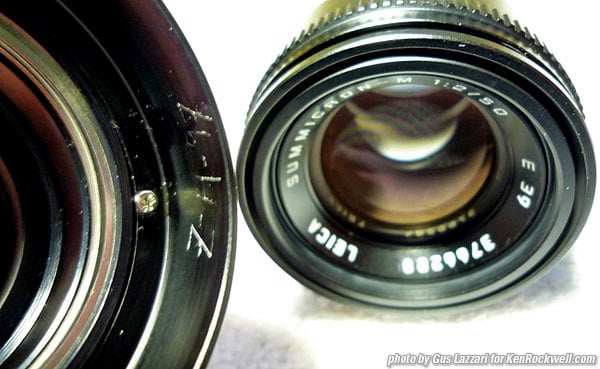
Crude internal graffiti left by an unauthorized technician in 1997.
I sent it to Gus, and he did an outstanding job of cleaning it internally, and putting it all back together with no marks or signs that anything had been touched. Heck, Gus can service an "L" sealed M3 without breaking the seal, so for Gus, it was easy to clean up the sloppy work done earlier. Thanks Gus!
More Information top
Comparison table of every 50mm SUMMICRON made since 1953.
Leica's data, starting at page 42, and especially page 48 for performance graphs.
Leica's current data for the:
50mm f/2.5 SUMMARIT-M (budget lens)
50mm f/2 SUMMICRON-M (this lens)
© Ken Rockwell. All rights reserved. Alle Rechte vorbehalten.
Help me help you top
I support my growing family through this website, as crazy as it might seem.
If you find this as helpful as a book you might have had to buy or a workshop you may have had to take, feel free to help me continue helping everyone.
If you've gotten your gear through one of my links or helped otherwise, you're family. It's great people like you who allow me to keep adding to this site full-time. Thanks!
If you haven't helped yet, please do, and consider helping me with a gift of $5.00.
The biggest help is when you use any of these links when you get anything. It costs you nothing, and is this site's, and thus my family's, biggest source of support. These places always have the best prices and service, which is why I've used them since before this website existed. I recommend them all personally.
Thanks for reading!
Ken
Home Donate New Search Gallery Reviews How-To Books Links Workshops About Contact
